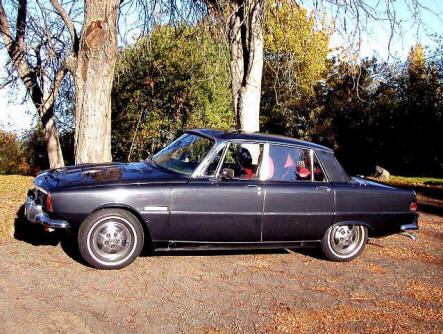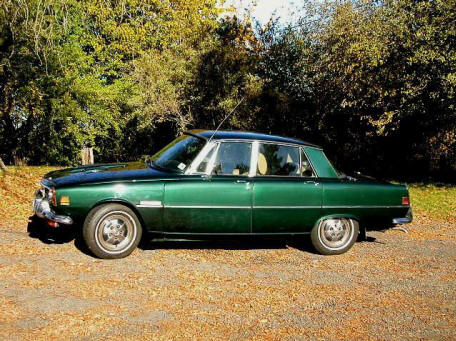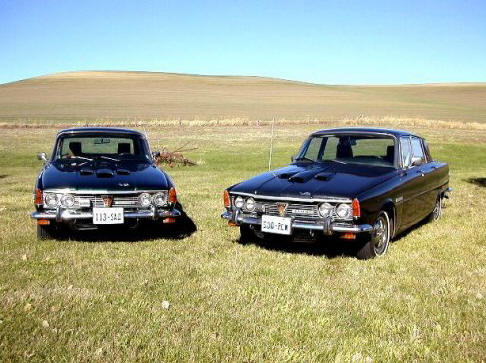(from Kent and Joanne Harkins)
|
Dear Rudiger – and all other P6 devotees. My wife Joanne, and I, would be happy to share some of our Rover ‘adventures’ with you and other fans of the marque. We’ve also included some photos, if you care to post them. We bought our first Rover, a mint 1968 2000 TC, in Scottsdale, Arizona, in the winter of 1972. We did not know anything about Rovers at that time, we just liked to experience as many different cars as we could, especially if they were a little bit ‘different’ (we’ve had about 1900 different cars in our lives so far, but in the last few years we seem to have slowed our ‘acquisitive pace’ considerably). Anyway, as I mentioned, the car was absolutely beautiful – with no cosmetic flaws. We bought it on the spot. It was British Racing Green, with a black leather interior. At the time, we lived in Flagstaff, Arizona – about 140 miles north of Scottsdale. Not only is it to the north, but Flagstaff lies about 7200 feet above sea level. Therefore, even though it is located in what is normally considered the hottest and driest part of the United States, it does get considerable snow (and cold) in the winter months. That particular winter the total season’s snowfall was approximately 120”, as I recall. All was proceeding fine on our journey home, until we reached the 4000’ elevation. All of a sudden, a very large orange warning light of the far left side of the instrument panel began to flash, slowly, and somewhat ominously. The farther (and higher) we traveled that night; the faster, longer, and brighter it flashed – eventually glowing continuously. We were out in the middle of nowhere, and it was late at night, and we were in a strange car that we knew nothing about. Then, it began to snow. As the miles ticked by, the snowstorm got worse, until eventually it was blizzarding. The few other cars on the road were sliding as much as we were (the car did not have any snow tires, being from warm Scottsdale). It should be obvious to the reader by now, that my wife and I had no idea of the existence of Rover’s advanced ‘Icelert’ system. Fortunately, we did arrive home safely – at least we were able to get within a block of our house before we got stuck. That winter and spring, we enjoyed the car very much. The only problem that it had was a persistent ‘running-on, or dieseling’ problem. The only way that we could shut off the car was to put it in gear and slip the clutch with the brakes applied. We were unable to find a competent mechanic, and did not know enough ourselves to remedy the situation. The available fuel was not of a high enough octane rating, and it never dawned on us to change the timing. It may have had a carbon deposit in a cylinder that kept igniting the residual vapors. Anyway, we were going to be moving at the beginning of the summer, so as the end of the school year approached, we put all of our vehicles up for sale, and planned on keeping the last remaining one (the other vehicles, besides the Rover, were a 1962 Peugeot 403; and a 1948 Ford Step Van that had been converted into a motor home). The Rover sold to a guy from San Francisco, that already had a 3500S. Seeing his made us know that we would have one (or more, as it turned out), too.
It was the late 1980’s before we got our first 3500S (and we still have it). We had moved to Washington State by this time to attend graduate school, and a friend of ours, from northern Idaho, was as interested in cars as we were – he owned what turned out to be our next Rover. The whole time that he had the car it looked pretty shabby –various colored body panels, mostly gold and white. He decided to have it re-painted the original gray. I went with him to pick it up, and he absolutely hated the color. The painter agreed to repaint it the next day. That color choice was a quite acceptable dark blue-gray. I told our friend that whenever he got ready to sell the car, that we would be buyers for it. However, our friend had been so disheartened by the whole affair that he no longer was interested in the car, and sold it to us right away. It now has approximately 300,000 miles, and all it has ever needed were a timing chain and gears, a water pump and radiator, exhaust repairs, brakes, u-joints, and tires. We have been very happy with it, as you might guess. We have a derelict 2000 SC with a perfect body, if we ever need to replace any body panels.
Our other current 3500S was purchased this last winter, on eBay, in Denver. The car had only one owner, and purportedly had traveled only 89,000 miles (we don’t believe it). It did come with $9600 in receipts over the preceding 3000 miles. We were not at all happy with the car when it arrived. It was a lesson that you have to look at a car yourself before buying – and we even had my brother-in-law look at the car twice prior to purchase. After we bought the car, and had arranged for shipment, it began to blizzard throughout the entire western United States. Luckily, it arrived safely. We spent a few more thousands of dollars on it, and it has become a fantastic driver, although by no means a show car. We drive our cars, so they all get a few nicks now and then. Our main reason for buying the car was that it has air conditioning. Both of us are not fans of the heat (that’s why we left Arizona). After we had it repaired by our great local mechanic (Deda’s; in Pullman, WA), it has given flawless service this past year. We are very happy with it, and our other Rover. I can’t see why we would ever want to get rid of them. They are distinctive, powerful, economical, and safe. They never fail to draw attention, but are not pretentious. What more could a person ask of their car?
|


